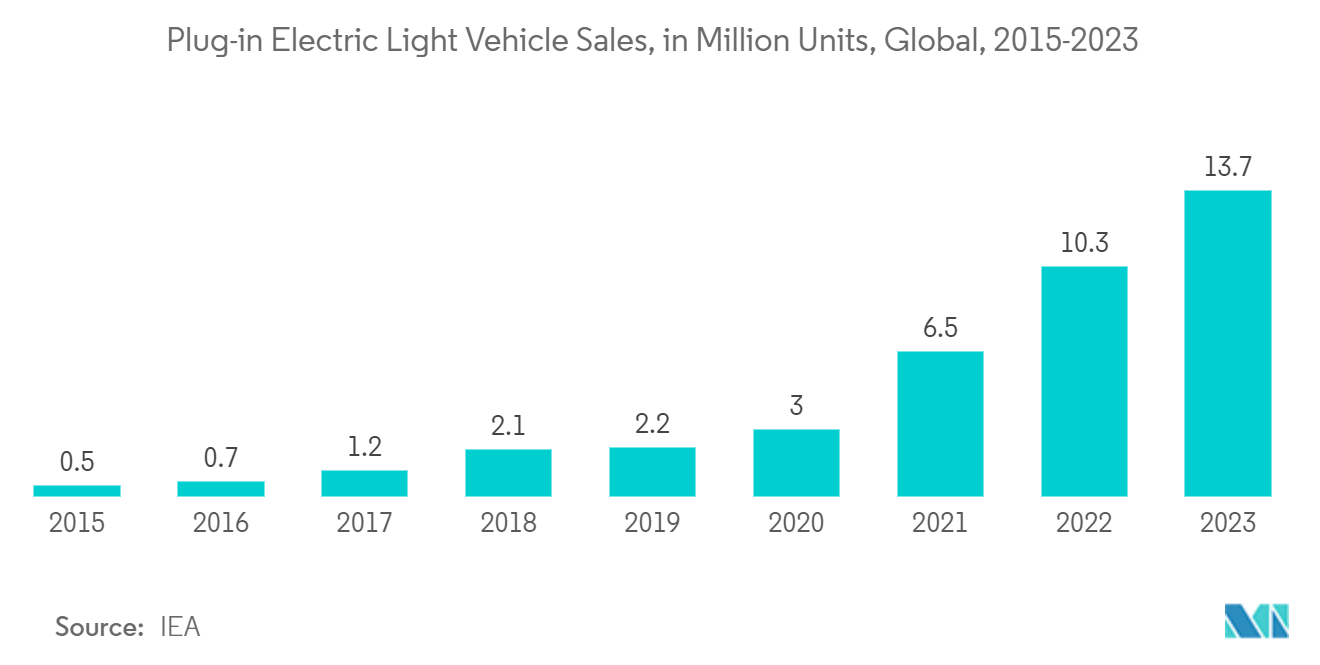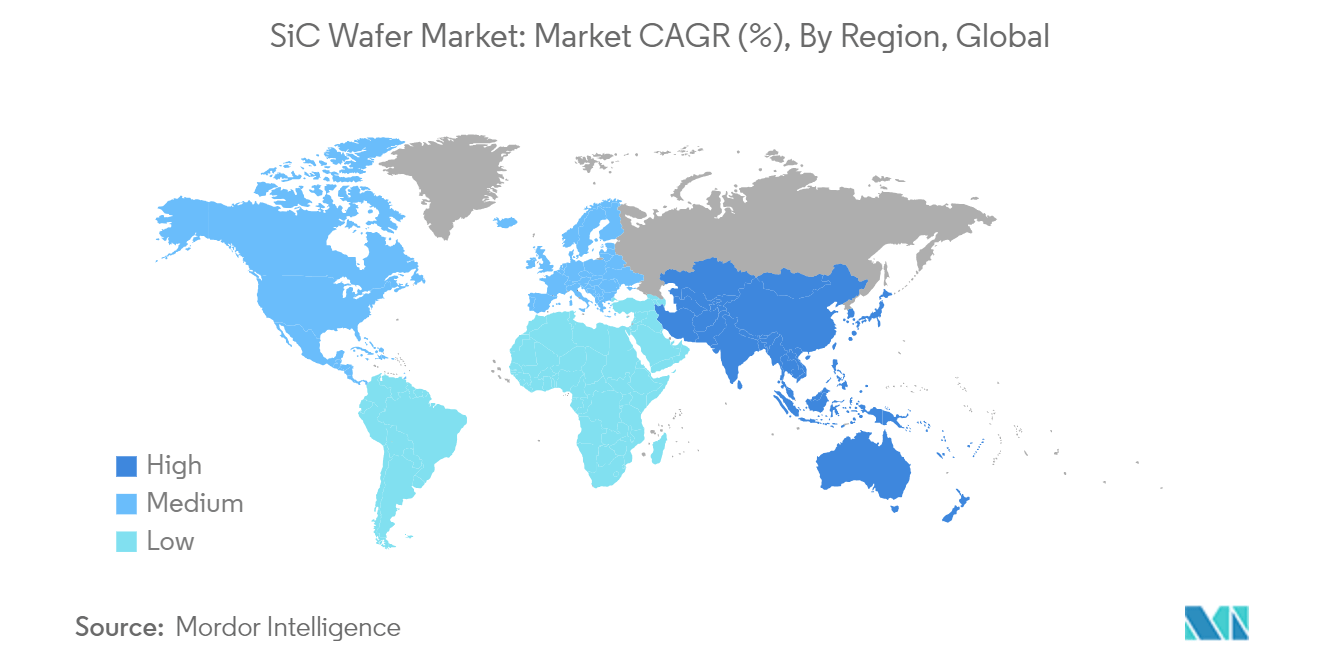Market Trends of SiC Wafer Industry
Automotive and Electric Vehicles (EVs) Industry to be the Largest End User
- SiC possesses superior thermal conductivity to silicon, facilitating high-temperature functionality with uncomplicated cooling regulation. It exhibits a significantly higher critical electric field strength, enabling it to endure the elevated voltages required for rapid battery charging. These attributes have paved the way for extensive utilization of SiC wafers within the Automotive industry.
- The increasing utilization of silicon carbide (SiC) wafers in various automotive chips has reached a critical juncture where most chipmakers now perceive it as a reasonably secure investment. SiC exhibits immense potential for numerous automotive applications, especially in battery electric vehicles. It can enhance the driving range per charge compared to silicon, decrease the battery charging time, and significantly contribute to the overall efficiency equation by delivering the same range with reduced battery capacity and weight.
- SiC has become an advanced technology that is employed as a substitute for silicon in numerous applications. Integrating SiC wafers in electric vehicles has enhanced efficiency, extended range, reduced weight, and lowered costs for the entire vehicle, consequently amplifying the power density of control electronics. Endeavors were undertaken to boost the efficiency and range of electric cars (EVs) by minimizing the weight and cost of the overall vehicle. As a result, the concept of utilizing SiC for EVs emerged, aligning with the escalating power density of control electronics.
- SiC finds one of its primary uses in electric vehicles (EVs) as the main inverter. This inverter plays a crucial role in converting the high DC voltage from the batteries into the necessary AC voltage to drive the traction electric motor. Compared to inverters based on IGBT technology and having the same structure, SiC provides an efficiency enhancement ranging from 6-10%. The main inverter benefits significantly from SiC’s lower conduction losses, mainly when operating under partial load conditions. This increased effectiveness results in extended range or reduced battery size, saving space and cost.
- The market is set to benefit significantly from the rising demand for battery electric vehicles, as well as the increasing sales and investments. The global automotive industry is undergoing a significant transformation, as highlighted by the International Energy Agency (IEA), with profound implications for the energy sector.
- EVs are gaining traction in the market, which has also increased the range. According to IEA, electric car markets are seeing exponential growth as almost 14 million new electric cars were registered globally in 2023, bringing their total number on the roads to 40 million. Electric car sales in 2023 were 3.5 million higher than in 2022, a 35% year-on-year increase. Electric cars accounted for around 18% of all cars sold in 2023, up from 14% in 2022. These trends indicate that growth remains robust as electric car markets mature. Battery electric cars accounted for 70% of the electric car stock in 2023.

Asia Pacific to Register Major Growth
- The Asia-Pacific is a major market for silicon carbide wafers worldwide, which government policies have also helped because of its dominating position in the global semiconductor market. Taiwan, India, China, Japan, and South Korea have driven the region's semiconductor industry, which comprises a considerable share of the global semiconductor market. In contrast, other regions such as Thailand, Vietnam, Singapore, and Malaysia have also contributed significantly to its dominance.
- Significant market growth can be attributed to the rising demand for energy-efficient hybrid electric vehicles in several nations, including China, to reduce the effects of rising environmental pollution. In addition, China retains its status as the leading vehicle market globally, boasting the highest annual sales and manufacturing output. By 2025, the nation is poised to reach a milestone, producing an estimated 35 million vehicles domestically.
- For instance, China's automotive sector is proliferating, and the region plays a more significant role in the global auto industry. China is one of the top countries that have adopted electric vehicles, which are becoming increasingly popular. In August 2023, China's new energy vehicle sales reached 846,000 units, with passenger electric vehicles accounting for 808,000 units and commercial electric vehicles for 39,000 units. Specifically, sales figures for passenger battery electric vehicles (BEVs) stood at 559,000 units, while passenger plug-in hybrid electric vehicles (PHEVs) saw sales of 248,000 units.
- According to the IEA, new electric car registrations in China hit 8.1 million in 2023, marking a 35% increase from the previous year as consumers switched from gas-guzzler models due to government subsidies and high oil prices. Automotive battery management systems are commonly used in electric vehicles, including electric cars, trucks, etc. Semiconductors, such as battery-balancing ICs, are crucial safety and functionality enablers in such applications.
- China is the largest semiconductor market, not just in Asia but also in the world. The country is also attracting large investments from many major chip manufacturers to expand chip production by setting up new factories. Chinese companies' global chip sales are rising, largely due to rising US-China tensions and nationwide efforts to develop China's chip sector, including government subsidies, purchasing preferences, and other preferential measures.


